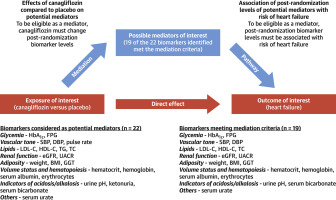当前位置:
X-MOL 学术
›
JACC Heart Fail.
›
论文详情
Our official English website, www.x-mol.net, welcomes your
feedback! (Note: you will need to create a separate account there.)
Mediators of the Effects of Canagliflozin on Heart Failure in Patients With Type 2 Diabetes.
JACC: Heart Failure ( IF 10.3 ) Pub Date : 2019-10-29 , DOI: 10.1016/j.jchf.2019.08.004 JingWei Li 1 , Mark Woodward 2 , Vlado Perkovic 3 , Gemma A Figtree 4 , Hiddo J L Heerspink 5 , Kenneth W Mahaffey 6 , Dick de Zeeuw 7 , Frank Vercruysse 8 , Wayne Shaw 9 , David R Matthews 10 , Bruce Neal 11
JACC: Heart Failure ( IF 10.3 ) Pub Date : 2019-10-29 , DOI: 10.1016/j.jchf.2019.08.004 JingWei Li 1 , Mark Woodward 2 , Vlado Perkovic 3 , Gemma A Figtree 4 , Hiddo J L Heerspink 5 , Kenneth W Mahaffey 6 , Dick de Zeeuw 7 , Frank Vercruysse 8 , Wayne Shaw 9 , David R Matthews 10 , Bruce Neal 11
Affiliation

|
OBJECTIVES
The purpose of this study was to explore potential mediators of the effects of canagliflozin on heart failure in the CANVAS Program (CANagliflozin cardioVascular Assessment Study; NCT01032629 and CANagliflozin cardioVascular Assessment Study-Renal; NCT01989754).
BACKGROUND
Canagliflozin reduced the risk of heart failure among patients with type 2 diabetes in the CANVAS Program. The mechanism of protection is uncertain.
METHODS
The percentages of mediating effects of 19 biomarkers were determined by comparing the hazard ratios for the effect of randomized treatment from an unadjusted model and from a model adjusting for the biomarker of interest. Multivariable analyses were used to assess the joint effects of biomarkers that mediated most strongly in univariable analyses.
RESULTS
Early changes after randomization in levels of 3 biomarkers (urinary albumin:creatinine ratio, serum bicarbonate, and serum urate) were identified as mediating the effect of canagliflozin on heart failure. Average post-randomization levels of 14 biomarkers (systolic blood pressure, low-density lipoprotein and high-density lipoprotein cholesterol, total cholesterol, urinary albumin:creatinine ratio, weight, body mass index, gamma glutamyltransferase, hematocrit, hemoglobin concentration, serum albumin, erythrocyte concentration, serum bicarbonate, and serum urate) were identified as significant mediators. Individually, the 3 biomarkers with the largest mediating effect were erythrocyte concentration (45%), hemoglobin concentration (43%), and serum urate (40%). In a parsimonious multivariable model, erythrocyte concentration, serum urate, and urinary albumin:creatinine ratio were the 3 biomarkers that maximized cumulative mediation (102%).
CONCLUSIONS
A diverse set of potential mediators of the effect of canagliflozin on heart failure were identified. Some mediating effects were anticipated, whereas others were not. The mediators that were identified support existing and novel hypothesized mechanisms for the prevention of heart failure with sodium glucose cotransporter 2 inhibitors.
中文翻译:

Canagliflozin对2型糖尿病患者心力衰竭的影响的调节剂。
目的本研究的目的是在CANVAS计划中探讨canagliflozin对心力衰竭的影响的潜在介体(CANagliflozin心血管评估研究; NCT01032629和CANagliflozin心血管评估研究(肾脏); NCT01989754)。背景技术Canagliflozin在CANVAS计划中降低了2型糖尿病患者发生心力衰竭的风险。保护的机制尚不确定。方法通过比较来自未调整模型和针对目标生物标志物调整模型的随机治疗效果的危险比,确定了19种生物标志物介导作用的百分比。多变量分析用于评估在单变量分析中介导作用最强的生物标志物的联合作用。结果随机分配的3种生物标志物(尿白蛋白:肌酐比,血清碳酸氢盐和血清尿酸盐)水平的早期变化被确定为卡那列净对心力衰竭的介导作用。随机化后的14种生物标志物的平均水平(收缩压,低密度脂蛋白和高密度脂蛋白胆固醇,总胆固醇,尿白蛋白:肌酐比,体重,体重指数,γ-谷氨酰胺基转移酶,血细胞比容,血红蛋白浓度,血清白蛋白,红细胞浓度,血清碳酸氢盐和血清尿酸盐被确定为重要的介质。单独地,具有最大介导作用的3种生物标志物是红细胞浓度(45%),血红蛋白浓度(43%)和血清尿酸盐(40%)。在简约多变量模型中,红细胞浓度,血清尿酸盐,和尿白蛋白:肌酐比值是使累积调解最大化的三个生物标志物(102%)。结论确定了canagliflozin对心力衰竭影响的多种潜在介质。预期会有一些调解效果,而没有其他效果。确定的介体支持使用钠葡萄糖共转运蛋白2抑制剂预防心力衰竭的现有和新颖的假设机制。
更新日期:2019-10-29
中文翻译:

Canagliflozin对2型糖尿病患者心力衰竭的影响的调节剂。
目的本研究的目的是在CANVAS计划中探讨canagliflozin对心力衰竭的影响的潜在介体(CANagliflozin心血管评估研究; NCT01032629和CANagliflozin心血管评估研究(肾脏); NCT01989754)。背景技术Canagliflozin在CANVAS计划中降低了2型糖尿病患者发生心力衰竭的风险。保护的机制尚不确定。方法通过比较来自未调整模型和针对目标生物标志物调整模型的随机治疗效果的危险比,确定了19种生物标志物介导作用的百分比。多变量分析用于评估在单变量分析中介导作用最强的生物标志物的联合作用。结果随机分配的3种生物标志物(尿白蛋白:肌酐比,血清碳酸氢盐和血清尿酸盐)水平的早期变化被确定为卡那列净对心力衰竭的介导作用。随机化后的14种生物标志物的平均水平(收缩压,低密度脂蛋白和高密度脂蛋白胆固醇,总胆固醇,尿白蛋白:肌酐比,体重,体重指数,γ-谷氨酰胺基转移酶,血细胞比容,血红蛋白浓度,血清白蛋白,红细胞浓度,血清碳酸氢盐和血清尿酸盐被确定为重要的介质。单独地,具有最大介导作用的3种生物标志物是红细胞浓度(45%),血红蛋白浓度(43%)和血清尿酸盐(40%)。在简约多变量模型中,红细胞浓度,血清尿酸盐,和尿白蛋白:肌酐比值是使累积调解最大化的三个生物标志物(102%)。结论确定了canagliflozin对心力衰竭影响的多种潜在介质。预期会有一些调解效果,而没有其他效果。确定的介体支持使用钠葡萄糖共转运蛋白2抑制剂预防心力衰竭的现有和新颖的假设机制。











































 京公网安备 11010802027423号
京公网安备 11010802027423号